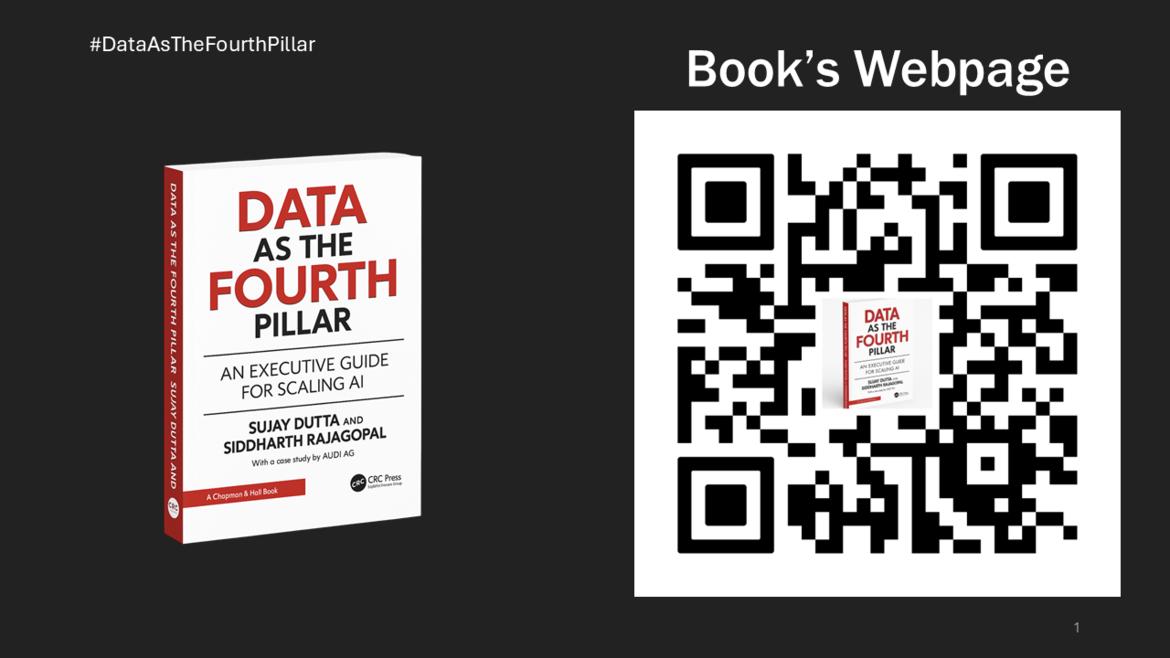Audi is turning data into a strategic pillar

In “Data as the Fourth Pillar,” Audi AG’s Rüdiger Eck contributed a case study exploring how the company is building a “Data & Analytics Factory” to strengthen its Production & Logistics operations. In this dotmagazine interview, Rüdiger shares how Audi approached data as a strategic pillar, what challenges came up along the way, and what other organizations – large and small – might learn from this experience.
dotmagazine: What motivated Audi to contribute to this book?
Rüdiger Eck: Our contribution is driven by the belief that real-world examples inspire action, hoping to empower others, thus helping to move our industries into a new phase of growth and productivity.
This is because long-standing business models throughout the industry have been undergoing profound transformational efforts over the past decade or so, many of them with data at the heart of this evolution. Integrating data into their operations, from fragmented sources to scaling insights for decision-making is a significant challenge for many, often carefully balancing resources and aspirations. Recognizing these shared struggles, we were inspired to contribute to this book by detailing Audi Production’s journey to provide on-the-ground implementation feedback on what works and what doesn’t – a case study that offers practical lessons for others navigating similar terrain.
Your case study centers on the Data & Analytics Factory in Production & Logistics. What problem were you trying to solve?
Rüdiger: We aimed to solve fragmentation across distributed BI and AI teams by centralizing efforts within the Data & Analytics Factory in Production & Logistics. This enabled us to scale data products and customer solutions more effectively, accelerate development cycles, and improve operational efficiency. A key success factor was co-developing a unified data strategy with stakeholders, ensuring alignment on priorities and value delivery. By fostering collaboration and standardizing processes, we created a foundation for sustainable innovation and measurable impact across the organization.
What was the hardest part of that journey?
Rüdiger: The hardest part was aligning decentralized stakeholders around a centralized model. We had to prove that central teams could still meet local operational needs reliably. Convincing both business and IT that only joint, cross-functional teams could drive efficiency was equally challenging. Lastly, we needed to show that distributed teams actually shared similar skills and goals – making integration not just logical, but essential for delivering scalable, high-impact solutions.
Were there moments that convinced people of the value of treating data as a pillar?
Rüdiger: It took time to shift mindsets, but joint value tree workshops helped align business needs and demonstrate the strategic role of data. The turning point came when the first integrated BI and AI products were deployed on the shop floor, offering unprecedented features and insights. These tangible results convinced stakeholders that treating data as a core pillar could unlock real operational value and drive innovation across Production & Logistics.
Where do you see the strongest connection between data maturity and AI-driven automation?
Rüdiger: The strongest connection between data maturity and AI-driven automation lies in the ability to deliver reliable, scalable, and value-driven solutions. Mature data environments provide standardized governance, high-quality datasets, and robust pipelines – critical prerequisites for automation.
Data observability plays a pivotal role here: it ensures transparency, monitors data health, and detects anomalies in real time, which is essential for maintaining trust in automated AI systems. Without mature data practices and observability, automation risks propagating errors at scale.
What lessons from Audi’s experience would you highlight for other industries?
Rüdiger: One key lesson is that success in data and AI requires joint, stable teams from both business and IT to ensure alignment and speed. We relocated experts from business units into centralized data and AI organizations to break silos and foster collaboration. Another insight: treat data and AI differently – they are deeply interdependent but serve distinct functions, demanding unique skills, roles, and actions. Finally, funding must be strategic: invest in data projects for long-term capability and AI solutions based on clear business value. This balanced approach accelerates innovation while maintaining governance and scalability across industries.
Looking ahead, what opportunities and challenges do you see for data-driven automation?
Rüdiger: Looking ahead, data-driven automation offers immense opportunities but also significant challenges. To unlock its potential, organizations must improve data observability to ensure trust and reliability across automated processes. Building an IT-based intelligence layer will be critical for orchestrating complex workflows and enabling real-time decision-making. At the same time, we need to foster data products as scalable entities, ensuring they can be reused and extended across business domains. Managing FinOps effectively will help control costs as automation scales. Ultimately, the challenge is staying ahead of the game – continuously innovating while maintaining governance, efficiency, and measurable business impact.

Data as the Fourth Pillar
“Data as the Fourth Pillar: An Executive Guide for Scaling AI” is available at datathefourthpillar.com. The book provides comprehensive frameworks including the Maturity Framework, QCS Framework, and Data Operating Model to help enterprises accelerate their data-centric journey.
📚 Citation:
Eck, Rüdiger. (November 2025). Data as the Fourth Pillar: Audi’s Data & Analytics Factory in Production & Logistics. dotmagazine. https://www.dotmagazine.online/issues/ai-automation/audi-data-and-analytics-factory
Rüdiger Eck is an accomplished professional in the automotive industry with a distinguished career spanning over two decades. Working for two German premium OEMs, Rüdiger has over 20 years of technical track record in global automotive production, including winning two consecutive world champion titles with the Mercedes Formula 1 team. He has spearheaded various Audi teams from the early stages of digitalization in the production industry and now directs Audi’s Data and Analytics Factory for Production & Logistics, as well as overseeing Volkswagen Group data activities. With a German master’s degree in mechanical engineering, Rüdiger has a strong passion for managing technical and organizational change and bridging the gap between production and IT. His expertise and leadership continue to drive innovation and excellence in the automotive sector.
FAQ
Why did Audi establish a “Data & Analytics Factory” for its Production & Logistics operations?
• To overcome fragmentation of BI and AI teams
• To enable centralised, scalable development of data-driven solutions
• To boost efficiency and insight deployment across logistics and production
What were the key challenges Audi encountered when implementing its centralised model?
• Aligning decentralised units with a central strategy
• Building trust that central teams could meet operational needs
• Shifting from siloed teams to collaborative structures
How does data maturity relate to AI-driven automation in Audi’s case study?
• Trusted, observable data pipelines are foundational
• Poor data governance leads to unreliable automation
• Real-time quality checks are key to scaling AI with confidence
What practical lessons did Audi recommend for other organisations?
• Form stable, cross-functional teams
• Treat data and AI as distinct but interlinked capabilities
• Fund strategically: data for long-term capability, AI for direct business value
What future opportunities and challenges does Audi highlight regarding data-driven automation?
• Opportunity: Reusable data products and orchestration layers
• Challenge: Managing costs and governance at scale
• Goal: Deliver measurable business impact sustainably
How does this case study align with eco’s mission and the broader Internet-industry context?
• Supports eco’s mission to advance responsible digital infrastructure
• Highlights scalable industrial innovation through data governance
• Contributes to eco Competence Group themes on automation, AI, and cloud ecosystems
Please note: The opinions expressed in articles published by dotmagazine are those of the respective authors and do not necessarily reflect the views of the publisher, eco – Association of the Internet Industry.




